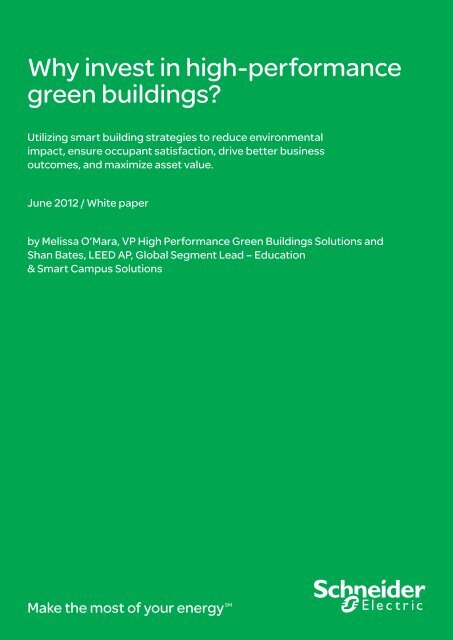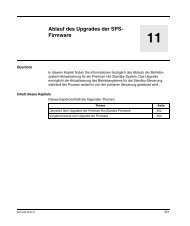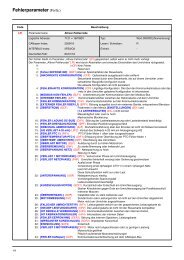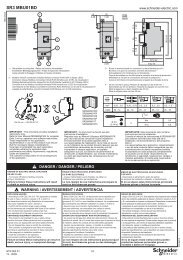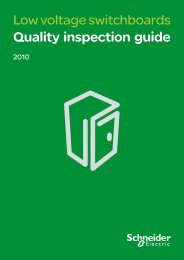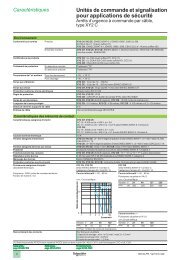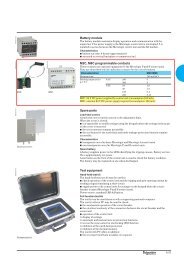Why invest in high-performance green buildings? - Schneider Electric
Why invest in high-performance green buildings? - Schneider Electric
Why invest in high-performance green buildings? - Schneider Electric
Create successful ePaper yourself
Turn your PDF publications into a flip-book with our unique Google optimized e-Paper software.
<strong>Why</strong> <strong><strong>in</strong>vest</strong> <strong>in</strong> <strong>high</strong>-<strong>performance</strong><br />
<strong>green</strong> build<strong>in</strong>gs?<br />
Utiliz<strong>in</strong>g smart build<strong>in</strong>g strategies to reduce environmental<br />
impact, ensure occupant satisfaction, drive better bus<strong>in</strong>ess<br />
outcomes, and maximize asset value.<br />
June 2012 / White paper<br />
by Melissa O’Mara, VP High Performance Green Build<strong>in</strong>gs Solutions and<br />
Shan Bates, LEED AP, Global Segment Lead – Education<br />
& Smart Campus Solutions<br />
Make the most of your energy SM
Summary<br />
Executive summary ...........................................................................................3<br />
Introduction .......................................................................................................4<br />
I. <strong>Why</strong> do we need to <strong><strong>in</strong>vest</strong> <strong>in</strong> <strong>high</strong>-<strong>performance</strong> <strong>green</strong> build<strong>in</strong>gs? .....................6<br />
II. How do <strong>green</strong> build<strong>in</strong>gs improve bus<strong>in</strong>ess? ..................................................10<br />
III. Where do we stand today? ..........................................................................14<br />
IV. How do we deliver smarter, converged solutions designed for<br />
<strong>high</strong> <strong>performance</strong>? .....................................................................................18<br />
V. What is the future promise of <strong>green</strong> build<strong>in</strong>g? ...............................................21<br />
V. Conclusion...................................................................................................24<br />
The follow<strong>in</strong>g people contributed content to this whitepaper:<br />
Kathleen Batcheller, Communications Manager, High Performance Green Build<strong>in</strong>gs Solutions<br />
Phil Davis, Senior Manager, Demand Response Resource Center<br />
Olivier Demazure, Global Segment Lead – Office & Real Estate Solutions<br />
Scott Henneberry, VP Smart Grid Strategy<br />
Dr. Satish Kumar, Energy Efficiency Ambassador & Vice President, Energy Management Solutions, India<br />
Andy Marsh, Team Leader, Global Build<strong>in</strong>gs Solutions Architects<br />
Henri Obara, BREEAM International Assessor, LEED Green Associate, HOMES Program Regulations and<br />
Standards Manager
Executive summary<br />
Property <strong><strong>in</strong>vest</strong>ors and developers are constantly seek<strong>in</strong>g new strategies to<br />
deliver susta<strong>in</strong>able build<strong>in</strong>gs that attract tenants and buyers while maximiz<strong>in</strong>g<br />
“<strong>green</strong> value.” Investments <strong>in</strong> <strong>green</strong> build<strong>in</strong>gs can produce measureable<br />
f<strong>in</strong>ancial value, such as <strong>in</strong>creased rental rates and asset value, reduced risk of<br />
depreciation, and <strong>high</strong>er tenant attraction and retention rates.<br />
Meanwhile, occupants want build<strong>in</strong>gs that help them attract and reta<strong>in</strong> the<br />
best talent, foster collaboration and <strong>in</strong>novation, and <strong>in</strong>crease employee<br />
productivity and well-be<strong>in</strong>g. At the same time, they need to reduce operat<strong>in</strong>g<br />
costs, energy use, and environmental impacts. All of these factors help<br />
organizations meet corporate social responsibility goals.<br />
Increased market demand and clear f<strong>in</strong>ancial rewards, coupled with mount<strong>in</strong>g<br />
government regulations and shareholder pressures, provide multiple <strong>in</strong>centives<br />
to own and occupy <strong>high</strong>-<strong>performance</strong> <strong>green</strong> build<strong>in</strong>gs that leverage <strong>in</strong>novation<br />
and deliver triple bottom l<strong>in</strong>e value throughout the entire build<strong>in</strong>g life cycle.<br />
The strategies outl<strong>in</strong>ed <strong>in</strong> this document will provide ideas on how to make<br />
<strong>green</strong> build<strong>in</strong>gs perform on all levels—from profitability to susta<strong>in</strong>ability, and<br />
everyth<strong>in</strong>g between.<br />
White paper<br />
<strong>Why</strong> <strong><strong>in</strong>vest</strong> <strong>in</strong> <strong>high</strong>-<strong>performance</strong> <strong>green</strong> build<strong>in</strong>gs? | 3
Introduction<br />
Conduct a quick <strong>in</strong>ternet search for the term “<strong>green</strong> build<strong>in</strong>gs,” and you will get<br />
18.3 million hits <strong>in</strong> less than a second. Words like “susta<strong>in</strong>able” and “<strong>green</strong>” have<br />
long been associated with premium build<strong>in</strong>gs. Today, these words have become<br />
part of our global conversation about everyth<strong>in</strong>g from a worldwide movement<br />
towards energy efficient, environmentally sound build<strong>in</strong>gs to enterprise-wide real<br />
estate portfolios. Acronyms like GBL, BIM, and IPD have entered the scene.<br />
We live <strong>in</strong> a time of global climate change challenges, <strong>in</strong>creas<strong>in</strong>g regulatory<br />
pressures for greater energy efficiency and carbon reduction, consumer <strong>in</strong>terest,<br />
and employee pressure on corporations. These trends have fueled corporate<br />
social responsibility (CSR) programs, voluntary enrollment <strong>in</strong> non-governmental<br />
organization (NGO) <strong>in</strong>itiatives like the Carbon Disclosure Project and the Climate<br />
Registry, and <strong>in</strong>tegration of susta<strong>in</strong>ability <strong>in</strong>to daily bus<strong>in</strong>ess practices.<br />
All of this, coupled with <strong>in</strong>creased energy demand and ris<strong>in</strong>g energy costs, has<br />
created many challenges but few answers. Build<strong>in</strong>g owners, operators, and<br />
occupants are left to sift through mount<strong>in</strong>g “<strong>green</strong> noise” to understand how<br />
to achieve environmental and economic benefits through smart build<strong>in</strong>g design<br />
and operation strategies.<br />
So, what is a <strong>high</strong>-<strong>performance</strong><br />
<strong>green</strong> build<strong>in</strong>g?<br />
A <strong>high</strong>-<strong>performance</strong> <strong>green</strong> build<strong>in</strong>g can be thought of as a liv<strong>in</strong>g organism,<br />
and as with all liv<strong>in</strong>g th<strong>in</strong>gs, it must have a nurtur<strong>in</strong>g environment to achieve<br />
susta<strong>in</strong>ed health and <strong>performance</strong> over its life. Such build<strong>in</strong>gs are designed<br />
for economic and environmental <strong>performance</strong> over time, with an appreciation<br />
for unique local climate and cultural needs, ultimately provid<strong>in</strong>g for the health,<br />
safety, and productivity of build<strong>in</strong>g occupants. Architectural, systems, and enduse<br />
design, coupled with cont<strong>in</strong>ual care and monitor<strong>in</strong>g, lead to lower energy<br />
use, reduced CO 2 emissions, and focused environmental stewardship while<br />
provid<strong>in</strong>g long term value to the community, build<strong>in</strong>g occupants, and build<strong>in</strong>g<br />
owners. Triple bottom l<strong>in</strong>e benefits can be expected—measurable benefits for<br />
people, profit, and the planet.<br />
In addition, <strong>high</strong>-<strong>performance</strong> <strong>green</strong> build<strong>in</strong>gs have <strong>in</strong>telligent connections<br />
with energy sources, <strong>in</strong>clud<strong>in</strong>g the smart grid, and <strong>in</strong>creas<strong>in</strong>gly are vital<br />
components of susta<strong>in</strong>able, smart urban plans that leverage symbiotic, whole<br />
system design pr<strong>in</strong>ciples to m<strong>in</strong>imize waste and maximize efficiency.<br />
Green build<strong>in</strong>g pays<br />
A fundamental change is tak<strong>in</strong>g place. With the rapid <strong>in</strong>crease of renewable<br />
energy use, and the convergence of <strong>in</strong>formation technology and build<strong>in</strong>g<br />
technologies, we are on the path toward net zero energy or even positive<br />
energy build<strong>in</strong>gs. This is reflected <strong>in</strong> the fact that smart grid, smart cities, ecodistricts,<br />
and <strong>green</strong> campuses are already be<strong>in</strong>g built and retrofitted.<br />
People<br />
White paper<br />
“The build<strong>in</strong>g is a citizen of the city<br />
and has an obligation to society.”<br />
- Xiaowei Xu, PhD., LEED AP,<br />
Chief Eng<strong>in</strong>eer, Shenzhen<br />
Institute of Build<strong>in</strong>g Research<br />
Lower energy<br />
use & CO 2<br />
emissions<br />
Higher talent<br />
retention rates,<br />
employee<br />
loyalty<br />
Fewer sick<br />
days, improved<br />
well-be<strong>in</strong>g<br />
Improved<br />
occupant<br />
experience<br />
Planet<br />
Corporate social<br />
responsibility<br />
Empower<strong>in</strong>g<br />
economic &<br />
environmental<br />
susta<strong>in</strong>ability<br />
Regulatory<br />
compliance<br />
Improved<br />
stock<br />
<strong>performance</strong><br />
Increased<br />
occupancy<br />
and tenant<br />
retention<br />
rates<br />
Increased<br />
build<strong>in</strong>g value &<br />
rental rates<br />
<strong>Why</strong> <strong><strong>in</strong>vest</strong> <strong>in</strong> <strong>high</strong>-<strong>performance</strong> <strong>green</strong> build<strong>in</strong>gs? | 4<br />
Profit
The <strong>green</strong> build<strong>in</strong>g movement is now mature enough to show proof of its<br />
economic <strong>green</strong> value <strong>in</strong> the real estate market for both build<strong>in</strong>g owners and<br />
tenants. 1, 2, 3, 4, 5, 6 Further, when implemented strategically, <strong>green</strong> construction<br />
and retrofits br<strong>in</strong>g social as well as f<strong>in</strong>ancial benefits.<br />
However, <strong>green</strong> certification does NOT guarantee a <strong>high</strong>-<strong>performance</strong><br />
build<strong>in</strong>g! (See section III for more on this topic). Increas<strong>in</strong>gly, there is<br />
recognition that <strong>green</strong> build<strong>in</strong>gs must be designed from <strong>in</strong>ception to m<strong>in</strong>imize<br />
environmental impact throughout the build<strong>in</strong>g life cycle. Design<strong>in</strong>g for <strong>high</strong><br />
<strong>performance</strong> from a life-cycle perspective is critical, and depends on several<br />
fairly recent <strong>in</strong>novations <strong>in</strong> the design/build process: Build<strong>in</strong>g Information<br />
Model<strong>in</strong>g (BIM) and Integrated Project Delivery (IPD), and ever more<br />
sophisticated energy and f<strong>in</strong>ancial model<strong>in</strong>g tools and methods.<br />
High-<strong>performance</strong> <strong>green</strong> build<strong>in</strong>gs of the next decade will be designed by<br />
cross-functional teams us<strong>in</strong>g complex energy and build<strong>in</strong>g model<strong>in</strong>g tools,<br />
and apply<strong>in</strong>g the newest <strong>in</strong>formation gleaned from these models. Look<strong>in</strong>g to<br />
the enormous potential with<strong>in</strong> the <strong>green</strong> build<strong>in</strong>gs movement and focus<strong>in</strong>g on<br />
the triple bottom l<strong>in</strong>e, smart teams of people are collaborat<strong>in</strong>g, <strong>in</strong>novat<strong>in</strong>g, and<br />
partner<strong>in</strong>g to br<strong>in</strong>g a whole new breed of <strong>high</strong>-<strong>performance</strong> <strong>green</strong> build<strong>in</strong>gs<br />
<strong>in</strong>to the marketplace.<br />
1 Do<strong>in</strong>g <strong>green</strong> by do<strong>in</strong>g good? An analysis of the f<strong>in</strong>ancial <strong>performance</strong> of Green Office Build<strong>in</strong>gs <strong>in</strong> the USA, RICS research, 2009<br />
2 Dow Jones Susta<strong>in</strong>ability Index, SAM, 2010<br />
3 Ethical Stock Indexes: Does Susta<strong>in</strong>ability Pay Off? C. Consolandia, P. Nascenzib, A. Jaiswal-Dale, Italy, US, 2008<br />
4 The US Mayors Climate Protection Agreement; http://www.usmayors.org/climateprotection/documents/mcpAgreement.pdf<br />
5 The American College and University Presidents Climate Commitment; http://www.presidentsclimatecommitment.org<br />
6 Green Economy Post, T. de Morsella, 2009<br />
White paper<br />
Smart teams of people are<br />
collaborat<strong>in</strong>g, <strong>in</strong>novat<strong>in</strong>g, and<br />
partner<strong>in</strong>g to br<strong>in</strong>g a whole new<br />
breed of <strong>high</strong>-<strong>performance</strong> <strong>green</strong><br />
build<strong>in</strong>gs <strong>in</strong>to the marketplace.<br />
<strong>Why</strong> <strong><strong>in</strong>vest</strong> <strong>in</strong> <strong>high</strong>-<strong>performance</strong> <strong>green</strong> build<strong>in</strong>gs? | 5
I. <strong>Why</strong> do we need to <strong><strong>in</strong>vest</strong> <strong>in</strong> <strong>high</strong><strong>performance</strong><br />
<strong>green</strong> build<strong>in</strong>gs?<br />
For forward th<strong>in</strong>k<strong>in</strong>g build<strong>in</strong>g owners, operators, and tenants, the need<br />
for <strong>green</strong> build<strong>in</strong>gs is clear. Accord<strong>in</strong>g to the World Bus<strong>in</strong>ess Council for<br />
Susta<strong>in</strong>able Development, build<strong>in</strong>gs account for up to 40% of energy use <strong>in</strong><br />
most countries. 7 With global energy demand outgrow<strong>in</strong>g current production,<br />
there is a compell<strong>in</strong>g reason to act with force. Us<strong>in</strong>g energy efficiency<br />
measures and a focus on susta<strong>in</strong>able practices, build<strong>in</strong>g owners and operators<br />
who <strong><strong>in</strong>vest</strong> <strong>in</strong> <strong>green</strong> build<strong>in</strong>g strategies will reduce the impact of climate<br />
change, preserve the quality of human life, improve bus<strong>in</strong>ess <strong>performance</strong>, and<br />
meet governmental regulations.<br />
Follow<strong>in</strong>g are some of the compell<strong>in</strong>g factors that are driv<strong>in</strong>g <strong><strong>in</strong>vest</strong>ment <strong>in</strong><br />
<strong>high</strong>-<strong>performance</strong> build<strong>in</strong>gs:<br />
The need to reduce climate change<br />
The energy dilemma is here to stay. Our planet faces an unprecedented<br />
energy challenge, with global energy demand grow<strong>in</strong>g faster than current<br />
production capacity, result<strong>in</strong>g <strong>in</strong> dim<strong>in</strong>ish<strong>in</strong>g supplies and <strong>in</strong>creas<strong>in</strong>g prices. By<br />
2050, energy demand will double 8 <strong>in</strong> order to keep pace with demographic,<br />
economic, and <strong>in</strong>dustrial growth throughout the world. With<strong>in</strong> this same<br />
timel<strong>in</strong>e, we must cut <strong>in</strong> half the amount of carbon gas emissions compared to<br />
1990 levels 9 to avoid the dramatic consequences of climate change that will<br />
affect every citizen, bus<strong>in</strong>ess, and country.<br />
The Intergovernmental Panel on Climate Change reports a projected<br />
population <strong>in</strong>crease from 7 billion today to 8.3 billion <strong>in</strong> 2030. 70 million of<br />
these people live <strong>in</strong> develop<strong>in</strong>g or emerg<strong>in</strong>g countries which are grow<strong>in</strong>g<br />
eight times faster than <strong>in</strong>dustrialized nations. As this new urban middle class<br />
economy emerges with access to consumer goods and services, it is obvious<br />
there will be a tremendous <strong>in</strong>crease <strong>in</strong> energy demand that must be satisfied.<br />
Accord<strong>in</strong>g to studies by the International Energy Agency, by the year 2030,<br />
three quarters of our energy sources will rema<strong>in</strong> CO 2 -related, creat<strong>in</strong>g grave<br />
consequences if the global temperature rises by 3°C. As energy consumption<br />
cont<strong>in</strong>ues to rise, it is imperative that we f<strong>in</strong>d a way to live with less reliance on<br />
fossil fuels, if we wish to protect the planet’s climate and preserve the fuels for<br />
future generations.<br />
High-<strong>performance</strong> <strong>green</strong> build<strong>in</strong>gs directly affect this issue by reduc<strong>in</strong>g<br />
environmental impacts <strong>in</strong> water, materials, waste, energy, and carbon<br />
emissions, while also prov<strong>in</strong>g that susta<strong>in</strong>ability does not mean people have<br />
to sacrifice functionality, productivity, or comfort. In fact, deploy<strong>in</strong>g <strong>in</strong>novative<br />
technology, <strong>in</strong> the context of holistic designs, leads to comfort for users, care<br />
for the community, and cash for the owner.<br />
7 Energy Efficiency <strong>in</strong> Build<strong>in</strong>gs, Bus<strong>in</strong>ess Realities and Opportunities, WBCSD, 2009<br />
8 International Energy Agency (IEA), 2009<br />
9 Intergovernmental Panel on Climate Change; http://www.ipcc.ch/<strong>in</strong>dex.htm<br />
White paper<br />
“The health status of millions of<br />
people is projected to be affected<br />
through, for example, <strong>in</strong>creases<br />
<strong>in</strong> malnutrition; <strong>in</strong>creased<br />
deaths, diseases and <strong>in</strong>jury due<br />
to extreme weather events;<br />
<strong>in</strong>creased burden of diarrheal<br />
diseases; <strong>in</strong>creased frequency<br />
of cardio-respiratory diseases<br />
due to <strong>high</strong>er concentrations of<br />
ground-level ozone <strong>in</strong> urban areas<br />
related to climate change.”<br />
- Climate Change 2007 Synthesis<br />
Report, IPCC<br />
<strong>Why</strong> <strong><strong>in</strong>vest</strong> <strong>in</strong> <strong>high</strong>-<strong>performance</strong> <strong>green</strong> build<strong>in</strong>gs? | 6
Ensure energy access and reliability<br />
Quality of life is directly impacted by availability and reliability of energy.<br />
Today, 1.3 billion people 10 (20% of the world’s population) have no access<br />
to electricity whatsoever. These people are essentially cut off from significant<br />
economic and social development, and they have limited access to<br />
educational opportunities and comprehensive healthcare.<br />
Even <strong>in</strong> countries where people and bus<strong>in</strong>esses have access to energy, lack<br />
of reliability can disrupt daily life, negatively impact the economy, and even<br />
threaten life. Severe weather conditions like heat waves and cold snaps put<br />
<strong>in</strong>tense pressure on electrical grid systems and can lead to power outages that<br />
threaten health and safety of <strong>in</strong>dividuals.<br />
Kuwait already uses 98.5% of grid capacity, accord<strong>in</strong>g to the Energy<br />
Information Adm<strong>in</strong>istration, and the Middle East has one of the world’s <strong>high</strong>est<br />
per capita consumption rates of electricity. The Gulf region is fac<strong>in</strong>g major<br />
<strong><strong>in</strong>vest</strong>ments to <strong>in</strong>crease grid capacity to meet the rapidly ris<strong>in</strong>g power demand<br />
and avoid power outages. Europe is expected to <strong><strong>in</strong>vest</strong> 1 trillion Euros through<br />
2020 <strong>in</strong> its power <strong>in</strong>frastructure to ensure reliability of service. 11 Many other<br />
areas of the world are experienc<strong>in</strong>g equally challeng<strong>in</strong>g circumstances that<br />
make it difficult to provide predictable, reliable energy, which has a direct<br />
negative impact on the quality of life for <strong>in</strong>dividuals and on the ability of<br />
companies to conduct bus<strong>in</strong>ess efficiently.<br />
As energy demand escalates all over the world, we need to make the grid<br />
<strong>green</strong>er and smarter—with more renewable energy sources and <strong>in</strong>telligence<br />
across the whole electricity network. In this context, <strong>high</strong>-<strong>performance</strong> <strong>green</strong><br />
build<strong>in</strong>gs can play an important role: build<strong>in</strong>gs can both generate and store<br />
electricity, and push it back out to the grid when the grid needs it most. In<br />
other words, build<strong>in</strong>gs can respond to the needs of the eco-district or smart<br />
city by both reduc<strong>in</strong>g use and releas<strong>in</strong>g stored energy back to the grid—thus<br />
ensur<strong>in</strong>g reliability and cont<strong>in</strong>uity of service, and contribut<strong>in</strong>g to improved<br />
quality of life for community members.<br />
Mitigate risks of energy price volatility<br />
and supply security<br />
As energy demands <strong>in</strong>crease, so do prices. But the equation is much more<br />
complicated than that. Ongo<strong>in</strong>g <strong>in</strong>stability <strong>in</strong> the Middle East and North Africa<br />
has a direct impact on world energy markets, both <strong>in</strong> terms of price and supply.<br />
The Fukushima Daiichi nuclear power plant disaster not only effectively took<br />
about 30% of Japan’s power supply offl<strong>in</strong>e (as the country shut down all 50<br />
plants for ma<strong>in</strong>tenance after the 2011 meltdown), 12 it caused a backlash of fear<br />
<strong>in</strong> many parts of the world that are now reconsider<strong>in</strong>g their own nuclear policies<br />
and potential associated risks. While Japan and other countries are still debat<strong>in</strong>g<br />
the role of nuclear power mov<strong>in</strong>g forward, it is easy to see how one <strong>in</strong>cident can<br />
have major, last<strong>in</strong>g ramification on energy supply, security, and costs.<br />
10 World Energy Outlook 2011, International Energy Agency<br />
11 Energy 2020—a strategy for competitive, susta<strong>in</strong>able and secure energy, European Commission,<br />
November 10, 2010; http://ec.europa.eu/energy/publications/doc/2011_energy2020_en.pdf<br />
12 http://www.huff<strong>in</strong>gtonpost.com/2012/05/25/japan-nuclear-energy_n_1544875.html<br />
White paper<br />
<strong>Why</strong> <strong><strong>in</strong>vest</strong> <strong>in</strong> <strong>high</strong>-<strong>performance</strong> <strong>green</strong> build<strong>in</strong>gs? | 7
Design<strong>in</strong>g and occupy<strong>in</strong>g <strong>high</strong>-<strong>performance</strong> <strong>green</strong> build<strong>in</strong>gs is a great riskmitigation<br />
strategy. In recent years, commodity speculators, <strong>in</strong> concert with<br />
<strong>in</strong>creas<strong>in</strong>gly erratic weather patterns, have played a major role <strong>in</strong> the volatility<br />
of energy prices <strong>in</strong> electricity, natural gas, and oil. Many companies spend<br />
immense funds to manage the risks of this volatility. High-<strong>performance</strong><br />
<strong>green</strong> build<strong>in</strong>gs reduce energy consumption—sometimes dramatically. Such<br />
build<strong>in</strong>gs can modify the patterns of use to avoid expensive peak rates and<br />
to become more efficient overall, regardless of time of day. Build<strong>in</strong>gs that<br />
generate energy through renewables can also sell energy back to the grid,<br />
thanks to the two-way communication <strong>in</strong>herent <strong>in</strong> the smart grid. A smart<br />
build<strong>in</strong>g knows how to respond to peak energy load and pull from the most<br />
renewable source of power.<br />
Meet energy efficiency and<br />
susta<strong>in</strong>ability regulations, <strong>in</strong>centives,<br />
and goals<br />
Although government mandates are <strong>in</strong>creas<strong>in</strong>g, there are no clear directives on<br />
how to reach goals. It is clear that <strong>green</strong> build<strong>in</strong>gs are an important part of the<br />
answer to the energy dilemma. As the built environment cont<strong>in</strong>ues its move<br />
through a major transformation, it holds an <strong>in</strong>credible opportunity for process,<br />
technology and human <strong>in</strong>novation.<br />
In 2010, the European Parliament and the Council of the European Union<br />
approved updates to the Energy Performance of Build<strong>in</strong>gs Directive, <strong>in</strong> order<br />
to strengthen and clarify exist<strong>in</strong>g build<strong>in</strong>g <strong>performance</strong> legislation. Among the<br />
agreements reached by member states are: 13<br />
• By 2020, all new build<strong>in</strong>gs will be designed to achieve “nearly zeroenergy”<br />
results, with energy sources com<strong>in</strong>g primarily from renewables<br />
• After 2018, all new build<strong>in</strong>gs occupied and owned by public authorities<br />
are nearly zero-energy build<strong>in</strong>gs<br />
• By 2020, 20% of energy supply for build<strong>in</strong>gs must come from<br />
renewable sources<br />
• Member states must implement mandatory certification (Energy<br />
Performance Certifications) of new build<strong>in</strong>gs, upon construction,<br />
and exist<strong>in</strong>g build<strong>in</strong>gs, at the time of sale or rent, along with periodic<br />
certification of public build<strong>in</strong>gs<br />
Regulation around the world<br />
<strong>in</strong> the European Union<br />
all new build<strong>in</strong>gs are nearly net zero<br />
<strong>in</strong> Ch<strong>in</strong>a<br />
CO2 reduction per GDP below 2005 levels<br />
<strong>in</strong> Australia<br />
Green Star rat<strong>in</strong>g required for new government<br />
build<strong>in</strong>gs (5 stars) and exist<strong>in</strong>g build<strong>in</strong>gs (4 stars)<br />
<strong>in</strong> India<br />
Mandatory<br />
compliance<br />
<strong>in</strong> the US<br />
13 http://www.eceee.org/build<strong>in</strong>gs/EPBD_Recast http://eurlex.europa.eu/LexUriServ/LexUriServ.do?uri=OJ:L:2010:153:0013:0035:EN:PDF<br />
White paper<br />
with GRIHA (Green Rat<strong>in</strong>g for Integrated Habitat Assessment)<br />
rat<strong>in</strong>g system for build<strong>in</strong>gs of the central government and<br />
public sector undertak<strong>in</strong>gs<br />
15% 2015<br />
of all federal build<strong>in</strong>gs >5000 ft 2 must conform to Zero-Net-<br />
Energy policy; all new build<strong>in</strong>gs designed after 2020 must<br />
meet the policy by 2030<br />
<strong>Why</strong> <strong><strong>in</strong>vest</strong> <strong>in</strong> <strong>high</strong>-<strong>performance</strong> <strong>green</strong> build<strong>in</strong>gs? | 8
Each year, floor stock <strong>in</strong> Ch<strong>in</strong>a <strong>in</strong>creases by another 2 billion square meters,<br />
which represents half of the world construction market. 14 This is driven<br />
by population growth, economic development, and dramatic and rapid<br />
urbanization. In 2009, Ch<strong>in</strong>a set a goal of 40%-45% CO 2 reduction (below<br />
2005 levels) per GDP by 2020. 15 Ch<strong>in</strong>a has also set a goal of us<strong>in</strong>g 15% nonfossil<br />
fuels by 2020. In its 12th Five Year Plan, which covers 2011-2015, Ch<strong>in</strong>a<br />
cont<strong>in</strong>ues to raise ambitions while shift<strong>in</strong>g its focus to quality, rather than rate,<br />
of growth. The plan seeks to:<br />
• Raise new build<strong>in</strong>g energy sav<strong>in</strong>g standards by 65-75%<br />
• Complete a total of 400 million square meters of exist<strong>in</strong>g build<strong>in</strong>g energy<br />
efficiency renovation<br />
• Expand build<strong>in</strong>g efficiency to the rural market<br />
• Implement national <strong>green</strong> build<strong>in</strong>g plans<br />
• Construct 1 billion square meters of new <strong>green</strong> build<strong>in</strong>gs, <strong>in</strong>clud<strong>in</strong>g<br />
government office build<strong>in</strong>gs, Eco-City attached projects, government<br />
subsidized projects, government <strong><strong>in</strong>vest</strong>ment projects, etc., and conduct<br />
mandatory GBL certification<br />
• Issue 500 new <strong>green</strong> build<strong>in</strong>g certificates (100-200 projects each year)<br />
• Provide f<strong>in</strong>ancial, policy and land support to <strong>green</strong> build<strong>in</strong>g developers 16<br />
These are only a few examples of governmental <strong>in</strong>itiatives that are tak<strong>in</strong>g place<br />
around the world, and their impact will only grow over time.<br />
14 GIM Research<br />
15 http://www.nrdc.org/<strong>in</strong>ternational/copenhagenaccords/<br />
16 Data from GIM Research and APCO Worldwide http://www.apcoworldwide.com/content/pdfs/ch<strong>in</strong>as_12th_five-year_plan.pdf<br />
White paper<br />
<strong>Why</strong> <strong><strong>in</strong>vest</strong> <strong>in</strong> <strong>high</strong>-<strong>performance</strong> <strong>green</strong> build<strong>in</strong>gs? | 9
II. How do <strong>green</strong> build<strong>in</strong>gs<br />
improve bus<strong>in</strong>ess?<br />
With <strong>green</strong> build<strong>in</strong>g design and operation, bus<strong>in</strong>ess success is assured as<br />
build<strong>in</strong>gs become both practical and profitable. This is true for several reasons,<br />
among them:<br />
• Commercial tenants or owner/operators of susta<strong>in</strong>able <strong>green</strong> commercial<br />
build<strong>in</strong>gs see tangible economic benefits <strong>in</strong>clud<strong>in</strong>g <strong>in</strong>creased rental rates,<br />
improved occupant comfort, and <strong>in</strong>creased stock prices 17 (See chart to<br />
the right for full benefits.)<br />
• Green<strong>in</strong>g exist<strong>in</strong>g build<strong>in</strong>gs can <strong>in</strong>crease property value while decreas<strong>in</strong>g<br />
operat<strong>in</strong>g costs 18<br />
• A public entity, such as a city or a university, can make strides <strong>in</strong> improved<br />
image and demonstrate to citizens and students that the organization<br />
focuses on environmental issues<br />
As an example of the last po<strong>in</strong>t, Experience Inc. surveyed nearly 2,500<br />
university students and recent graduates who overwhelm<strong>in</strong>gly expressed<br />
concern about climate change. 81% saw significance <strong>in</strong> work<strong>in</strong>g for an<br />
environmentally aware company, and 79% would probably accept a job at an<br />
eco-friendly company over a conventional one. 19<br />
Lower energy use <strong>in</strong>creases competitive<br />
edge and return on <strong><strong>in</strong>vest</strong>ment<br />
Beyond moral and ethical considerations, there are tangible economic reasons<br />
why susta<strong>in</strong>able build<strong>in</strong>g practices are a good <strong><strong>in</strong>vest</strong>ment for the future.<br />
For one th<strong>in</strong>g, payback improves as energy prices rise, so energy efficiency<br />
improvements become a better <strong><strong>in</strong>vest</strong>ment all the time.<br />
Recent analysis shows that the Return on Investment (ROI) for <strong>green</strong> build<strong>in</strong>gs<br />
is <strong>high</strong>er <strong>in</strong> both new construction and exist<strong>in</strong>g build<strong>in</strong>g projects, as compared<br />
to standard construction. Measur<strong>in</strong>g, monitor<strong>in</strong>g, and automat<strong>in</strong>g a build<strong>in</strong>g’s<br />
energy systems maximizes this <strong>high</strong> ROI by ensur<strong>in</strong>g equipment is only <strong>in</strong> use<br />
when needed and that all operations are at peak efficiency and effectiveness.<br />
ROI improvements reported by owners of <strong>green</strong> projects <strong>in</strong> the US were 9.9%<br />
on new construction and 19.2% exist<strong>in</strong>g build<strong>in</strong>g projects. 20<br />
This ROI is not surpris<strong>in</strong>g. There is strong evidence that <strong>green</strong> build<strong>in</strong>gs<br />
positively affect capital expenses (CapEx) and Operat<strong>in</strong>g Expenses (OpEx). For<br />
example:<br />
• Operat<strong>in</strong>g costs decrease 13.6% for new construction and 8.5% for<br />
exist<strong>in</strong>g build<strong>in</strong>g projects 21<br />
• Occupancy <strong>in</strong>creases 6.4% for new construction and 2.5% for<br />
exist<strong>in</strong>g build<strong>in</strong>g projects 22<br />
17 The U.S. Green Build<strong>in</strong>g Council, The Bus<strong>in</strong>ess Case for Green Build<strong>in</strong>g<br />
18 Build<strong>in</strong>g and Construction Authority (BCA) and the Department of Real Estate (DRE) <strong>in</strong> National University of S<strong>in</strong>gapore (NUS) Study, 2011<br />
19 http://www.<strong>green</strong>biz.com/news/2008/08/05/<strong>green</strong>-allure-college-grads<br />
20 McGraw Hill Construction, Green Outlook 2011: Green Trends Driv<strong>in</strong>g Growth, 2010<br />
21 Ibid.<br />
22 Ibid.<br />
Commercial build<strong>in</strong>g<br />
owners<br />
Increased rental<br />
rates<br />
White paper<br />
Commercial build<strong>in</strong>g<br />
tenants<br />
Lower operat<strong>in</strong>g<br />
costs<br />
Attract<strong>in</strong>g tenants Healthier,<br />
cleaner <strong>in</strong>door<br />
environmental<br />
quality<br />
Cost effective Immediate and<br />
measureable results<br />
Competitive<br />
differentiation<br />
PR and community<br />
benefits<br />
Risk mitigation Contribution to<br />
triple bottom l<strong>in</strong>e<br />
Source: The US Green Build<strong>in</strong>g Council, The Bus<strong>in</strong>ess<br />
Case for Green Build<strong>in</strong>g<br />
<strong>Why</strong> <strong><strong>in</strong>vest</strong> <strong>in</strong> <strong>high</strong>-<strong>performance</strong> <strong>green</strong> build<strong>in</strong>gs? | 10
• Rent <strong>in</strong>creases 6.1% <strong>in</strong> new construction and 1% <strong>in</strong> exist<strong>in</strong>g<br />
build<strong>in</strong>g projects 23<br />
• In Australia, the first ever Property Council of Australia/IPD Green Property<br />
Investment Index shows that office build<strong>in</strong>gs with environmental rat<strong>in</strong>gs do<br />
better (<strong>in</strong> growth and rental yield) than those without these rat<strong>in</strong>gs 24<br />
• Energy costs <strong>in</strong> the UK account for as much as 1/5 of bus<strong>in</strong>ess<br />
expenditures, so <strong><strong>in</strong>vest</strong><strong>in</strong>g <strong>in</strong> efficiency can lead to ga<strong>in</strong>s <strong>in</strong><br />
competitive advantage 25<br />
Companies <strong>in</strong>corporat<strong>in</strong>g susta<strong>in</strong>ability<br />
perform better<br />
Annual reports are overflow<strong>in</strong>g with the words “<strong>green</strong>” and “susta<strong>in</strong>able,”<br />
but does corporate social responsibility really matter to the bottom l<strong>in</strong>e? The<br />
answer is “yes.” Global 500 companies demonstrat<strong>in</strong>g leadership <strong>in</strong> carbon<br />
disclosure or carbon <strong>performance</strong> yielded twice the average return as the <strong>in</strong>dex<br />
as a whole. 26 Studies also show a significantly negative impact on productivity<br />
and return on equity for abandon<strong>in</strong>g corporate social responsibility standards. 27<br />
Look<strong>in</strong>g at figure 1, we clearly see that stock <strong>performance</strong> of the world’s<br />
most ethical companies is consistently <strong>high</strong>er than the S&P 500 Index.<br />
(Companies were measured <strong>in</strong> categories such as Corporate Citizenship and<br />
Responsibility; Corporate Governance; Innovation that Contributes to the<br />
Public Well Be<strong>in</strong>g; Industry Leadership; Executive Leadership and Tone from<br />
the Top; Legal, Regulatory and Reputation Track Record; and Internal Systems<br />
and Ethics/Compliance Program.)<br />
The lesson is clear. Ethics, “do<strong>in</strong>g the right th<strong>in</strong>g,” corporate social<br />
responsibility, environmental stewardship, community <strong>in</strong>volvement, workplace<br />
well-be<strong>in</strong>g—they all matter and br<strong>in</strong>g profitability. 28 High-<strong>performance</strong> <strong>green</strong><br />
build<strong>in</strong>gs support and facilitate all these factors. 29<br />
23 McGraw Hill Construction, Green Outlook 2011: Green Trends Driv<strong>in</strong>g Growth, 2010<br />
24 http://www.propertyoz.com.au/Article/NewsDetail.aspx?p=16&id=4129<br />
25 Guardian Susta<strong>in</strong>able Bus<strong>in</strong>ess, N. Grant, February 2011 http://www.guardian.co.uk/susta<strong>in</strong>able-bus<strong>in</strong>ess/british-gas-energy-efficiencycompetitive-advantage?INTCMP=ILCNETTXT3487<br />
26 CDP’s Annual Report F<strong>in</strong>ds Susta<strong>in</strong>able Companies are More Profitable T. Herrera, GreenBiz, September 2011<br />
27 Ethical Stock Indexes: Does Susta<strong>in</strong>ability Pay Off? C. Consolandia, P. Nascenzib, A. Jaiswal-Dale, Italy, US, 2008<br />
28 Ethispshere, 2011 World’s Most Ethical Companies. http://ethisphere.com/wme2011/<br />
29 University of Notre Dame Study F<strong>in</strong>ds Green Build<strong>in</strong>gs Improve Company F<strong>in</strong>ancial Performance and Lower Operational Costs, PRWEB,<br />
April 2012. http://www.prweb.com/releases/2012/4/prweb9390881.htm<br />
50%<br />
40%<br />
30%<br />
20%<br />
10%<br />
0%<br />
-10%<br />
-20%<br />
-30%<br />
-40%<br />
-50%<br />
White paper<br />
WME<br />
S&P 500<br />
2007 2008 2009 2010 2011<br />
Figure 1. Source: Ethispshere, 2011 World’s Most Ethical<br />
Companies<br />
<strong>Why</strong> <strong><strong>in</strong>vest</strong> <strong>in</strong> <strong>high</strong>-<strong>performance</strong> <strong>green</strong> build<strong>in</strong>gs? | 11
High-<strong>performance</strong> build<strong>in</strong>gs <strong>in</strong>crease<br />
comfort, productivity, and learn<strong>in</strong>g<br />
Work<strong>in</strong>g environments have a significant impact on employee productivity, and<br />
<strong>green</strong> build<strong>in</strong>gs offer better day light<strong>in</strong>g, outdoor views, and <strong>in</strong>door air quality<br />
for occupants to enjoy. These features of a healthy work environment help to<br />
attract and reta<strong>in</strong> employees.<br />
Moreover, occupant comfort and satisfaction reduces sick time, improves<br />
workplace occupancy rates (office spaces are typically unoccupied 30% of<br />
the time) and most importantly, improves productivity. S<strong>in</strong>ce salaries represent<br />
85% of total office build<strong>in</strong>gs bus<strong>in</strong>ess cost over a 25 year period, 30 productivity<br />
is by far the <strong>high</strong>est f<strong>in</strong>ancial factor <strong>in</strong> office build<strong>in</strong>g <strong>performance</strong>. In fact,<br />
accord<strong>in</strong>g to The Impact of Office Design on Bus<strong>in</strong>ess Performance, it has<br />
been estimated that “a 2-5 percent <strong>in</strong>crease <strong>in</strong> staff <strong>performance</strong> can cover<br />
the total cost of provid<strong>in</strong>g their accommodation.” 31<br />
A breakdown of bus<strong>in</strong>ess costs<br />
Salaries of occupants 85%<br />
Build<strong>in</strong>g - construction cost 6.5%<br />
M & E services - runn<strong>in</strong>g and ma<strong>in</strong>tenance 4%<br />
Furnish<strong>in</strong>gs and furniture 1.25%<br />
Build<strong>in</strong>g - ma<strong>in</strong>tenance 1%<br />
Clean<strong>in</strong>g, security, etc. 1%<br />
M & E services - depreciation 0.75%<br />
Furnish<strong>in</strong>gs and furniuture - ma<strong>in</strong>tenance and depreciation 0.5%<br />
Source: The Impact of Office Design on Bus<strong>in</strong>ess Performance<br />
That same report states that “differences <strong>in</strong> productivity as <strong>high</strong> as 25 per-cent<br />
have been reported between comfortable and uncomfortable staff.” 32 Green<br />
build<strong>in</strong>gs can improve staff comfort by reduc<strong>in</strong>g drafts, m<strong>in</strong>imiz<strong>in</strong>g floor-toceil<strong>in</strong>g<br />
temperature stratification, controll<strong>in</strong>g noise, improv<strong>in</strong>g <strong>in</strong>door air quality,<br />
and provid<strong>in</strong>g daylight<strong>in</strong>g and views. Furthermore, many <strong>green</strong> build<strong>in</strong>gs<br />
enable room level control and direct personal control of <strong>in</strong>dividual spaces and<br />
offices, thus meet<strong>in</strong>g the diverse needs of occupants. Additionally, <strong>in</strong>dividuals<br />
often benefit psychologically from know<strong>in</strong>g they have control over their<br />
workspace environment.<br />
In fact, the healthier environment provided by <strong>green</strong> build<strong>in</strong>gs has been shown<br />
to result <strong>in</strong> less illness, reduced absenteeism, and lower employee turnover.<br />
At Genzyme’s headquarters <strong>in</strong> the U.S., several environmental features have<br />
made employees happier and more productive: sick time was reduced by<br />
5%, 88% of employees reported improved well-be<strong>in</strong>g, and 72% of employees<br />
reported improved alertness and productivity. 33<br />
30 The Impact of Office Design on Bus<strong>in</strong>ess Performance, published by The Commission for Architecture & the Built Environment (CABE) and<br />
Brtiish Council for Offices, May 2005. This report was based <strong>in</strong> part on research done by DEGW.<br />
31 Ibid.<br />
32 Ibid.<br />
33 F<strong>in</strong>d<strong>in</strong>gs from a post-occupancy survey, reported on Genzyme Center’s website on the Value page. http://www.genzymecenter.com/<br />
White paper<br />
LEED Plat<strong>in</strong>um certified landmark <strong>green</strong> build<strong>in</strong>g:<br />
Genzyme Center, USA<br />
• Integrated build<strong>in</strong>g control, with energy<br />
monitor<strong>in</strong>g and management<br />
• 900 bl<strong>in</strong>ds, 7 heliostats and <strong>in</strong>door chandeliers<br />
reflect natural light<br />
• Daylight harvest<strong>in</strong>g<br />
• Outdoor views from every seat<br />
• 15% renewable energy<br />
• Operable w<strong>in</strong>dows<br />
• Indoor gardens and <strong>green</strong> roof<br />
• Brownfield site remediation<br />
Benefits to occupant<br />
• Reduced energy by 42%<br />
• Reduced water usage by 34%<br />
• Reduced sick time by 5%<br />
• Excellent <strong>in</strong>door air quality<br />
• Improved employee well-be<strong>in</strong>g, alertness,<br />
and productivity<br />
• Improved employee attraction and retention<br />
Photo credit: Peter Vanderwarker<br />
<strong>Why</strong> <strong><strong>in</strong>vest</strong> <strong>in</strong> <strong>high</strong>-<strong>performance</strong> <strong>green</strong> build<strong>in</strong>gs? | 12
Build<strong>in</strong>g <strong>green</strong> <strong>in</strong>creases property value<br />
and reduces liability risk<br />
Reduc<strong>in</strong>g the operat<strong>in</strong>g costs of a build<strong>in</strong>g or real estate portfolio <strong>in</strong>creases<br />
the net operat<strong>in</strong>g <strong>in</strong>come <strong>in</strong> more ways than direct sav<strong>in</strong>gs alone. In fact,<br />
accord<strong>in</strong>g to the New Build<strong>in</strong>gs Institute, <strong>in</strong>creas<strong>in</strong>g net operat<strong>in</strong>g <strong>in</strong>come<br />
<strong>in</strong>creases a build<strong>in</strong>g’s appraised value by ten times the annual cost sav<strong>in</strong>gs.<br />
And accord<strong>in</strong>g to a McGraw Hill Construction study, build<strong>in</strong>g <strong>green</strong> leads to an<br />
<strong>in</strong>crease <strong>in</strong> build<strong>in</strong>g values—10.9% for new construction and 6.8% for exist<strong>in</strong>g<br />
build<strong>in</strong>g projects. 34<br />
Green build<strong>in</strong>gs may also reduce the risk of lawsuits over mold-related and<br />
other health issues. Through the use of moisture-control detail<strong>in</strong>g, pollutionand-contam<strong>in</strong>ation<br />
rejection strategies, and ventilation tactics, <strong>green</strong> build<strong>in</strong>gs<br />
are healthier for occupants. S<strong>in</strong>ce most U.S. citizens, Europeans, and city<br />
dwellers globally spend about 90% of their time <strong>in</strong>doors, the quality of the<br />
<strong>in</strong>door environment is extremely important.<br />
34 McGraw Hill Construction, Green Outlook 2011: Green Trends Driv<strong>in</strong>g Growth, 2010<br />
White paper<br />
<strong>Why</strong> <strong><strong>in</strong>vest</strong> <strong>in</strong> <strong>high</strong>-<strong>performance</strong> <strong>green</strong> build<strong>in</strong>gs? | 13
III. Where do we stand today?<br />
We’ve seen the cost benefits and goals of <strong>high</strong>-<strong>performance</strong> <strong>green</strong> build<strong>in</strong>gs<br />
and why they are <strong>in</strong>tegral to address<strong>in</strong>g the energy and environmental<br />
challenges of today. The question is, how are we do<strong>in</strong>g on deliver<strong>in</strong>g the <strong>green</strong><br />
build<strong>in</strong>g value, and what more is needed to maximize this value?<br />
For the past 20 years or so, transformation <strong>in</strong> the built environment has been<br />
driven largely by <strong>green</strong> build<strong>in</strong>g certification programs, which have both<br />
created awareness and driven demand <strong>in</strong> the market for <strong>green</strong> build<strong>in</strong>gs.<br />
The Evolution of Green Build<strong>in</strong>g<br />
Certification<br />
When certification rat<strong>in</strong>g systems became viable, the <strong>in</strong>itial <strong>green</strong> build<strong>in</strong>gs focus<br />
was on the environmental impact of construction and design. This has evolved<br />
to <strong>in</strong>clude a focus on actual operational <strong>performance</strong> and energy use reduction,<br />
as evidenced by the development of LEED for Exist<strong>in</strong>g Build<strong>in</strong>gs (2004) <strong>in</strong>to<br />
LEED for Exist<strong>in</strong>g Build<strong>in</strong>gs: Operations and Ma<strong>in</strong>tenance (2009). LEED v4<br />
(scheduled for release <strong>in</strong> 2013) is expected to cont<strong>in</strong>ue this trend of emphasiz<strong>in</strong>g<br />
energy efficiency and operational <strong>performance</strong>.<br />
Major policies can transform the markets almost <strong>in</strong>stantly and cause a spike <strong>in</strong><br />
certification rates. Such is the case with the U.S. Government Services Agency<br />
(GSA) requirement that federal build<strong>in</strong>g achieve LEED Gold certification for all<br />
new construction and major renovations, and Australia’s Commercial Build<strong>in</strong>g<br />
Disclosure program that requires a Build<strong>in</strong>g Energy Efficiency Certificate 35 for<br />
all transact<strong>in</strong>g office build<strong>in</strong>gs.<br />
The follow<strong>in</strong>g is a summary of lead<strong>in</strong>g certification standards <strong>in</strong> use today.<br />
BREEAM and BREEAM In-Use<br />
The Build<strong>in</strong>g Research Establishment Environmental Assessment Method<br />
(BREEAM) was the first comprehensive <strong>green</strong> build<strong>in</strong>g assessment system<br />
<strong>in</strong>troduced <strong>in</strong> the world. BREEAM positions itself as be<strong>in</strong>g “the world’s foremost<br />
environmental assessment method and rat<strong>in</strong>g system for build<strong>in</strong>gs, with<br />
200,000 build<strong>in</strong>gs with certified BREEAM assessment rat<strong>in</strong>gs and over a million<br />
registered for assessment.” Established <strong>in</strong> the UK <strong>in</strong> 1990, it is now a global<br />
voluntary measurement rat<strong>in</strong>g that uses standard metrics aga<strong>in</strong>st established<br />
benchmarks to rate a build<strong>in</strong>g’s environmental <strong>performance</strong>.<br />
Established <strong>in</strong> 2009, BREEAM In-Use is an assessment method that helps build<strong>in</strong>g<br />
owners evaluate build<strong>in</strong>g operational costs and environmental <strong>performance</strong> after<br />
occupation. It consists of an onl<strong>in</strong>e self-assessment tool and 3rd party certification,<br />
and provides a clear roadmap to susta<strong>in</strong>ability improvements for build<strong>in</strong>g owners<br />
by <strong>high</strong>light<strong>in</strong>g problem areas, recommend<strong>in</strong>g improvements, and validat<strong>in</strong>g<br />
corporate social responsibility commitments. BREEAM In-Use is designed to<br />
reduce operational and runn<strong>in</strong>g costs, reduce carbon and improve susta<strong>in</strong>ability,<br />
enhance the value and marketability of property assets, give a transparent<br />
platform for negotiat<strong>in</strong>g build<strong>in</strong>g improvements with landlords and owners, and<br />
demonstrate compliance with environmental legislation and standards. 36<br />
35 Australian Government’s Commercial Build<strong>in</strong>g Discloser website: http://www.cbd.gov.au/<br />
36 http://www.breeam.org/page.jsp?id=66<br />
White paper<br />
<strong>Why</strong> <strong><strong>in</strong>vest</strong> <strong>in</strong> <strong>high</strong>-<strong>performance</strong> <strong>green</strong> build<strong>in</strong>gs? | 14
Leadership <strong>in</strong> Energy and Environmental Design (LEED)<br />
Accord<strong>in</strong>g to the U.S. Green Build<strong>in</strong>g Council (USGBC) website, “LEED<br />
certification provides <strong>in</strong>dependent, third-party verification that a build<strong>in</strong>g, home<br />
or community was designed and built us<strong>in</strong>g strategies aimed at achiev<strong>in</strong>g <strong>high</strong><br />
<strong>performance</strong> <strong>in</strong> key areas of human and environmental health: susta<strong>in</strong>able site<br />
development, water sav<strong>in</strong>gs, energy efficiency, materials selection, and <strong>in</strong>door<br />
environmental quality.” 37<br />
This mature rat<strong>in</strong>g system is comprehensive, cover<strong>in</strong>g both the design/<br />
construction and operations phases of the build<strong>in</strong>g lifecycle, while provid<strong>in</strong>g<br />
the flexibility of several categories, <strong>in</strong>clud<strong>in</strong>g new construction/major<br />
renovation, core and shell, commercial <strong>in</strong>teriors, retail, hospitals, schools,<br />
homes, and neighborhood development.<br />
Orig<strong>in</strong>ally released <strong>in</strong> 1998 by the USGBC, LEED is now a global standard<br />
utilized all around the world through the LEED International Program, <strong>in</strong><br />
countries such as Ch<strong>in</strong>a, India, Brazil, Russia, Italy, and Canada. As previously<br />
mentioned, the certification is constantly evolv<strong>in</strong>g to reward both <strong>green</strong> design<br />
and energy and operational efficiencies.<br />
Green Star and NABERS<br />
Australia has two—some say compet<strong>in</strong>g—rat<strong>in</strong>g systems: Green Star and<br />
NABERS. Launched <strong>in</strong> 2003 by the Green Build<strong>in</strong>g Council of Australia, Green<br />
Star is a build<strong>in</strong>g rat<strong>in</strong>g system that ranks <strong>green</strong> build<strong>in</strong>gs from 4 to 6 <strong>green</strong><br />
stars. A “4 Star Green Star” scores a facility as a “Best Practice,” while the<br />
<strong>high</strong>er score of 6 signifies “World Leadership.” The World Green Build<strong>in</strong>g<br />
Council reports that the Green Star System has also been adopted <strong>in</strong> New<br />
Zealand and South Africa.<br />
The National Australian Built Environment Rat<strong>in</strong>g System (NABERS) is a<br />
national <strong>in</strong>itiative to measure and compare the environmental <strong>performance</strong><br />
of build<strong>in</strong>gs. Of the two systems, it appears that the NABERS system<br />
measures what a build<strong>in</strong>g actually achieves, while Green Star is based on the<br />
environmental potential of a facility. 38 The Australian government, which leases<br />
15% of all commercial build<strong>in</strong>g space <strong>in</strong> the country, has <strong>in</strong>stituted a policy to<br />
lease only spaces with a 4.5 NABERS rat<strong>in</strong>g or <strong>high</strong>er. In addition, the national<br />
government requires a m<strong>in</strong>imum of 5 stars for new office build<strong>in</strong>gs and 4 stars<br />
for <strong>green</strong> leases, fit-outs, and refurbishments <strong>in</strong> the Green Star system for all<br />
national governmental build<strong>in</strong>gs, accord<strong>in</strong>g to Pike Research. 39<br />
Green Build<strong>in</strong>g Label (GBL)<br />
Ch<strong>in</strong>a’s M<strong>in</strong>istry of Hous<strong>in</strong>g and Urban-Rural Development (MOHURD)<br />
adm<strong>in</strong>isters the Green Build<strong>in</strong>g Label (GBL) through the Green Build<strong>in</strong>g Label<br />
Management Office (GBLMO). Established <strong>in</strong> 2008, GBLMO is entrusted by<br />
MOHURD to manage, regulate, and promote Ch<strong>in</strong>a’s GBL, which is ga<strong>in</strong><strong>in</strong>g<br />
<strong>in</strong> popularity over the LEED rat<strong>in</strong>g <strong>in</strong> the nation. 40 GBL consists of the Green<br />
Build<strong>in</strong>g Design Label (awarded at the design phase and valid for two years),<br />
37 http://www.usgbc.org/DisplayPage.aspx?CMSPageID=1988<br />
38 Wikipedia, Green Build<strong>in</strong>g Council of Australia http://www.gbca.org.au/, NABERS http://www.nabers.com.au/, and www.change2.net<br />
39 Pike Research, Global Certification Programs for New and Exist<strong>in</strong>g Build<strong>in</strong>gs <strong>in</strong> the Commercial and Residential Sectors: Market Analysis and<br />
Forecasts, May 2010.<br />
40 http://www.slideshare.net/geoff848/mohurd-three-star-system-how-does-it-work?type=presentation<br />
White paper<br />
First 6 Star Green Star Rat<strong>in</strong>g <strong>in</strong> Australia: Mirvac<br />
School of Susta<strong>in</strong>able Development at Bond<br />
University, Australia<br />
• Build<strong>in</strong>g management system <strong>in</strong>tegrates all<br />
systems and aggregates environmental data<br />
• Sub-meters cont<strong>in</strong>ually compare actual<br />
<strong>performance</strong> to energy benchmarks<br />
• Automated light<strong>in</strong>g control <strong>in</strong>cludes occupant<br />
detection and daylight adjustment<br />
• 85% renewable energy sources: solar, w<strong>in</strong>d,<br />
and regenerative drive lift<br />
• First educational <strong>in</strong>stitution to earn 6 Star<br />
Design Rat<strong>in</strong>g by the Green Build<strong>in</strong>g Council<br />
of Australia<br />
Benefits to owner/occupant<br />
• Reduced energy by 75%<br />
• Reduced carbon emissions by 82%<br />
• The build<strong>in</strong>g itself is a Liv<strong>in</strong>g Lab that supports<br />
the school’s susta<strong>in</strong>ability education mission,<br />
and <strong>in</strong>cludes a self-guided, <strong>in</strong>teractive<br />
energy display<br />
<strong>Why</strong> <strong><strong>in</strong>vest</strong> <strong>in</strong> <strong>high</strong>-<strong>performance</strong> <strong>green</strong> build<strong>in</strong>gs? | 15
and the Green Build<strong>in</strong>g Label (awarded after one year of occupancy and valid<br />
for three years). These voluntary certifications are for public and residential<br />
build<strong>in</strong>gs, and cover similar topics as LEED, <strong>in</strong>clud<strong>in</strong>g considerations of land<br />
use, energy, water, and materials, as well as <strong>in</strong>door air quality and <strong>performance</strong>.<br />
Green Rat<strong>in</strong>g for Integrated Habitat Assessment (GRIHA)<br />
GRIHA is a system developed jo<strong>in</strong>tly by the Indian M<strong>in</strong>istry of New and<br />
Renewable Energy (a government agency) and The Energy and Resource<br />
Institute (TERI), a prom<strong>in</strong>ent Indian non-governmental organization. GRIHA<br />
has established a grow<strong>in</strong>g presence <strong>in</strong> the public build<strong>in</strong>g sector. Although<br />
the requirements of GRIHA are similar to those of LEED, the documentation<br />
process is significantly different. It uses a star system rang<strong>in</strong>g from one to five<br />
and the GRIHA can be used for both new and exist<strong>in</strong>g applications.<br />
GRIHA has made strides to appeal to Indian designers and policymakers alike.<br />
For <strong>in</strong>stance, the program offers credits for design<strong>in</strong>g a naturally ventilated<br />
build<strong>in</strong>g. The f<strong>in</strong>al certificate is only awarded after build<strong>in</strong>g <strong>performance</strong> is<br />
verified based on one year of utility data, mak<strong>in</strong>g this certification one that is<br />
based on proven <strong>performance</strong> metrics. 41<br />
When certification is not enough<br />
Figure 2 42 shows how certification alone is not the answer: several LEED<br />
certified build<strong>in</strong>gs are perform<strong>in</strong>g worse than energy code basel<strong>in</strong>e! While<br />
<strong>green</strong> build<strong>in</strong>g certifications are a part of an important movement towards<br />
Measured Losses | Measured Sav<strong>in</strong>gs<br />
100%<br />
75%<br />
50%<br />
25%<br />
0%<br />
-25%<br />
-50%<br />
-75%<br />
Sav<strong>in</strong>g more<br />
than expected<br />
Sav<strong>in</strong>g less<br />
than expected<br />
These build<strong>in</strong>gs use<br />
more energy than<br />
the code basel<strong>in</strong>e!<br />
-100% 0% 25% 50% 75% 100%<br />
Proposed Sav<strong>in</strong>gs %<br />
Certified<br />
Silver<br />
Gold Plat<strong>in</strong>um<br />
Figure 2. Source: New Build<strong>in</strong>gs Institute report, Energy Performance of LEED ® for New<br />
Construction Build<strong>in</strong>gs, March 4, 2008<br />
41 Dr. Satish Kumar and www.griha<strong>in</strong>dia.org<br />
42 New Build<strong>in</strong>gs Institute report, Energy Performance of LEED ® for New Construction Build<strong>in</strong>gs, March 4, 2008<br />
White paper<br />
<strong>Why</strong> <strong><strong>in</strong>vest</strong> <strong>in</strong> <strong>high</strong>-<strong>performance</strong> <strong>green</strong> build<strong>in</strong>gs? | 16
energy efficiency and susta<strong>in</strong>ability—and greatly <strong>in</strong>crease awareness <strong>in</strong> this<br />
space—they are not the only solution. As mentioned previously, certifications<br />
such as BREEAM In-Use and LEED, have been updated to promote<br />
<strong>performance</strong> dur<strong>in</strong>g the ongo<strong>in</strong>g operation period of build<strong>in</strong>gs. This is a big<br />
step towards ensur<strong>in</strong>g <strong>high</strong> <strong>performance</strong> throughout the build<strong>in</strong>g life cycle.<br />
In addition to evolv<strong>in</strong>g <strong>green</strong> build<strong>in</strong>g standards, energy <strong>performance</strong><br />
standards are becom<strong>in</strong>g <strong>in</strong>creas<strong>in</strong>gly important <strong>in</strong> driv<strong>in</strong>g energy-efficient<br />
operation throughout the build<strong>in</strong>g life cycle. Some important<br />
standards <strong>in</strong>clude:<br />
• ISO 50001: Introduced <strong>in</strong> 2011 to establish requirements for energy<br />
management systems (EMS). ISO estimates that by “target<strong>in</strong>g broad<br />
applicability across national economic sectors, it is estimated that the<br />
standard could <strong>in</strong>fluence up to 60 % of the world’s energy use.” 43<br />
• BBC and BBC EFFINERGIE: These French “low energy” build<strong>in</strong>g<br />
labels specify m<strong>in</strong>imal energy use: 50 kWh/m 2 /year for residential new<br />
construction, and 50% below basel<strong>in</strong>e for commercial construction. S<strong>in</strong>ce<br />
the labels are tied directly to French energy regulations, the thresholds<br />
cont<strong>in</strong>ue to be lowered and are mov<strong>in</strong>g toward net zero and positive<br />
energy standards.<br />
• Bureau of Energy Efficiency’s (BEE) Star Label<strong>in</strong>g Program: The<br />
premise of this Indian program for exist<strong>in</strong>g build<strong>in</strong>gs is that build<strong>in</strong>g<br />
<strong>performance</strong>, more than anyth<strong>in</strong>g else, needs to be l<strong>in</strong>ked with actual<br />
energy use data. 44<br />
• ENERGY STAR: This US program lends its ENERGY STAR label to<br />
energy-efficient products and practices and boasts $18B <strong>in</strong> utility bill<br />
energy sav<strong>in</strong>gs <strong>in</strong> 2010 alone. 45<br />
The worldwide adoption of dozens of <strong>green</strong> build<strong>in</strong>g and energy standards has<br />
certa<strong>in</strong>ly helped to raise awareness about the potential of a transformed built<br />
environment. And pioneer<strong>in</strong>g projects like Green Office Meudon,<br />
TNT Centre, and Earth Rangers Centre—by tak<strong>in</strong>g a holistic approach and<br />
achiev<strong>in</strong>g net zero / positive energy results—are <strong>in</strong>spir<strong>in</strong>g build<strong>in</strong>g developers,<br />
operators, and occupants to achieve ever <strong>high</strong>er levels of <strong>performance</strong>. So how<br />
do we take these accomplishments <strong>in</strong>to the ma<strong>in</strong>stream?<br />
43 International Organization for Standardization: http://www.iso.org/iso/iso_50001_energy.pdf<br />
44 Dr. Satish Kumar and http://www.bee<strong>in</strong>dia.<strong>in</strong>t<br />
45 http://www.energystar.gov/<strong>in</strong>dex.cfm?c=about.ab_<strong>in</strong>dex<br />
<strong>Schneider</strong> <strong>Electric</strong> R&D and manufactur<strong>in</strong>g<br />
functions co-locate to boost <strong>in</strong>novation and<br />
collaboration: Horizon Build<strong>in</strong>g, France<br />
• Low energy design; consumes only<br />
40 kWh/m 2 /year<br />
• Low Energy Certified (Eff<strong>in</strong>ergie BBC)<br />
• High-Performance Energy and Associated<br />
Qualities Certified (HPE QA)<br />
• 100% on-site generated renewable energy<br />
meets all consumption needs for net<br />
zero results<br />
• Guaranteed energy <strong>performance</strong> contract<br />
• Grand Prix SIMI 2011 W<strong>in</strong>ner<br />
Benefits to owner/occupant<br />
• Optimized space utilization<br />
• Enhanced cooperation between R&D<br />
and production<br />
• Improved occupant well be<strong>in</strong>g<br />
• Reduced operat<strong>in</strong>g costs<br />
• Flexible, future forward architecture<br />
White paper<br />
• Achieved corporate social responsibility goals<br />
photo credit: Ludovic Mol<strong>in</strong>ier<br />
<strong>Why</strong> <strong><strong>in</strong>vest</strong> <strong>in</strong> <strong>high</strong>-<strong>performance</strong> <strong>green</strong> build<strong>in</strong>gs? | 17
IV. How do we deliver smarter, converged<br />
solutions designed for <strong>high</strong> <strong>performance</strong>?<br />
Accord<strong>in</strong>g to the International Eng<strong>in</strong>eer<strong>in</strong>g Consortium, only about 25% of total<br />
life cycle cost 46 of build<strong>in</strong>gs <strong>in</strong> the U.S. occurs at the design and construction<br />
phase. Unfortunately, this is when many decisions are made that will affect<br />
the <strong>performance</strong> of a build<strong>in</strong>g for many years <strong>in</strong>to the future. S<strong>in</strong>ce most of<br />
a build<strong>in</strong>g’s cost is associated with its ongo<strong>in</strong>g operations, it is clear that to<br />
reduce energy use and CO 2 emissions of build<strong>in</strong>gs, we must move toward<br />
a new “design for life cycle <strong>performance</strong>” paradigm—from conception to<br />
ongo<strong>in</strong>g operations and ma<strong>in</strong>tenance—<strong>in</strong>fus<strong>in</strong>g <strong>high</strong>-<strong>performance</strong> measures<br />
throughout every stage <strong>in</strong> the process.<br />
As the <strong>green</strong> build<strong>in</strong>g marketplace evolves, <strong>high</strong>-<strong>performance</strong> build<strong>in</strong>gs are<br />
becom<strong>in</strong>g more <strong>in</strong>telligent entities that susta<strong>in</strong> results over time. Mirror<strong>in</strong>g the<br />
human body which changes and adapts automatically to its environment,<br />
a <strong>high</strong>-<strong>performance</strong> <strong>green</strong> build<strong>in</strong>g can make better and better automatic<br />
decisions with converged solutions. Learn<strong>in</strong>g from the messag<strong>in</strong>g of its<br />
“nervous system,” these build<strong>in</strong>gs make more <strong>in</strong>telligent decisions and<br />
strategic changes over time.<br />
A simple example of self-adapt<strong>in</strong>g systems would be “optimum start,” <strong>in</strong> which<br />
an algorithm uses historical data <strong>in</strong> conjunction with <strong>in</strong>ternal and external<br />
build<strong>in</strong>g conditions to predict the optimal time to start the build<strong>in</strong>g’s systems<br />
to achieve operational conditions at the beg<strong>in</strong>n<strong>in</strong>g of occupancy. Conversely,<br />
“optimum stop” calculates the right time to stop a build<strong>in</strong>g’s systems while<br />
ma<strong>in</strong>ta<strong>in</strong><strong>in</strong>g m<strong>in</strong>imal drift <strong>in</strong> environmental conditions by the end of the<br />
build<strong>in</strong>g’s occupancy period.<br />
Intelligent tools and processes at the<br />
design phase facilitate successful<br />
<strong>in</strong>tegrated design/build outcomes<br />
As the demand for <strong>high</strong>-<strong>performance</strong> build<strong>in</strong>gs gets stronger, the need to<br />
build and design with a holistic approach becomes more relevant. Mirror<strong>in</strong>g a<br />
concept similar to how an aircraft is built, a <strong>high</strong>-tech and <strong>high</strong>-<strong>performance</strong><br />
build<strong>in</strong>g can leverage build<strong>in</strong>g <strong>in</strong>formation model<strong>in</strong>g (BIM). The National<br />
Build<strong>in</strong>g Information Model Standard Project Committee def<strong>in</strong>es BIM as “a<br />
digital representation of physical and functional characteristics of a facility.” By<br />
harness<strong>in</strong>g the power of a real, live data model, where <strong>in</strong>formation is added<br />
throughout the design process, one can immediately see the results of design<br />
approaches and how they affect future build<strong>in</strong>g <strong>performance</strong>. The BIM process<br />
helps close the gap between the <strong>green</strong> build<strong>in</strong>g vision and actual build<strong>in</strong>g<br />
<strong>performance</strong>, as does Integrated Project Delivery (IPD).<br />
In its guide on the topic, the AIA def<strong>in</strong>es IPD as “a project delivery approach<br />
that <strong>in</strong>tegrates people, systems, bus<strong>in</strong>ess structures, and practices <strong>in</strong>to<br />
a process that collaboratively harnesses the talents and <strong>in</strong>sights of all<br />
participants to optimize project results, <strong>in</strong>crease value to the owner, reduce<br />
waste, and maximize efficiency through all phases of design, fabrication, and<br />
46 This ratio differs <strong>in</strong> other parts of the world, due to labor costs.<br />
& analysis<br />
Ongo<strong>in</strong>g monitor<strong>in</strong>g<br />
Com mission<strong>in</strong>g<br />
Portfolio plann<strong>in</strong>g<br />
& assessment<br />
Build<strong>in</strong>g<br />
life cycle<br />
process<br />
design/build<br />
White paper<br />
Integrated<br />
Systems <strong>in</strong>stallation<br />
<strong>Why</strong> <strong><strong>in</strong>vest</strong> <strong>in</strong> <strong>high</strong>-<strong>performance</strong> <strong>green</strong> build<strong>in</strong>gs? | 18
construction.” Build<strong>in</strong>g Information Model<strong>in</strong>g and IPD are closely <strong>in</strong>terrelated,<br />
as SmartBIM states that the BIM model is the “centerpiece of Integrated<br />
Project Delivery.”<br />
The IPD process calls for early <strong>in</strong>corporation of predictive energy and<br />
f<strong>in</strong>ancial model<strong>in</strong>g, with regular iterations as the design progresses. A team of<br />
designers used this process, <strong>in</strong> a proof-of-concept project, to create a zeroemissions<br />
design called Net Zero Court for a site <strong>in</strong> St. Louis, Missouri. The<br />
goal was to create a market-rate build<strong>in</strong>g design “that produces and exports<br />
at least as much emissions-free renewable energy as it imports and uses, from<br />
emission-produc<strong>in</strong>g energy sources annually.”<br />
The design team performed comparative model<strong>in</strong>g of more than 90 different<br />
strategies at the predesign stage. Then, us<strong>in</strong>g follow-up analysis, the team<br />
was able to select a “bundle” of strategies that <strong>in</strong>corporated literally hundreds<br />
of specific <strong>green</strong> opportunities, with predicted carbon emission and cost<br />
implications. The analysis covered a wide range of factors, from <strong>in</strong>sulation<br />
and w<strong>in</strong>dow design, to light<strong>in</strong>g, cool<strong>in</strong>g and heat<strong>in</strong>g, to fans, pumps, and<br />
plug loads.<br />
The team was able to model the complex <strong>in</strong>teraction of all these variables<br />
iteratively throughout the design stage, with constant improvement and<br />
ref<strong>in</strong>ement, result<strong>in</strong>g <strong>in</strong> a build<strong>in</strong>g design where <strong>performance</strong> drove design,<br />
<strong>in</strong>stead of the other way around. (More on this project can be viewed at<br />
www.netzerocourt.com.)<br />
Ongo<strong>in</strong>g monitor<strong>in</strong>g, analysis, and<br />
improvements drive susta<strong>in</strong>ed<br />
<strong>performance</strong><br />
Even if a build<strong>in</strong>g is designed or retrofitted for <strong>high</strong> <strong>performance</strong>, it won’t<br />
rema<strong>in</strong> that way without active energy management. The most effective energy<br />
management plan is comprised of four key steps, shown <strong>in</strong> figure 3. These<br />
four steps are:<br />
• Measure energy usage<br />
• Fix the basics<br />
• Automate<br />
• Monitor, control, and improve<br />
A critical component of this life cycle <strong>in</strong>volves monitor<strong>in</strong>g, ma<strong>in</strong>ta<strong>in</strong><strong>in</strong>g,<br />
and improv<strong>in</strong>g build<strong>in</strong>g operations. This can be achieved with cont<strong>in</strong>uous<br />
commission<strong>in</strong>g, which is different from commission<strong>in</strong>g. Commission<strong>in</strong>g is<br />
the process of ensur<strong>in</strong>g that build<strong>in</strong>g systems are <strong>in</strong>stalled and operated to<br />
provide the <strong>performance</strong> envisioned by the owner, and primarily focuses on<br />
br<strong>in</strong>g<strong>in</strong>g the build<strong>in</strong>g’s operations to the orig<strong>in</strong>al design <strong>in</strong>tent. Cont<strong>in</strong>uous<br />
commission<strong>in</strong>g, on the other hand, focuses on optimiz<strong>in</strong>g operation and<br />
control of build<strong>in</strong>g systems. It often identifies issues related to the orig<strong>in</strong>al<br />
system commission<strong>in</strong>g and <strong>high</strong>lights the difference between design <strong>in</strong>tent<br />
Retrofit designed for life cycle <strong>performance</strong>:<br />
Musgrove Park Hospital, UK<br />
White paper<br />
• Performance contract guarantees €21M (£17M)<br />
<strong>in</strong> energy sav<strong>in</strong>gs over the next 20 years<br />
• Reduced carbon emissions by 43%<br />
• Reduced energy use by over 40%<br />
Benefits to owner/occupant<br />
• Best-<strong>in</strong>-class technologies to maximize<br />
energy <strong>performance</strong><br />
• Improved environment of care and<br />
patient safety<br />
• Reduced ma<strong>in</strong>tenance costs<br />
• M<strong>in</strong>imized bus<strong>in</strong>ess risk from energy<br />
price volatility<br />
• Money from energy sav<strong>in</strong>gs can be re<strong><strong>in</strong>vest</strong>ed<br />
<strong>in</strong> other estate projects<br />
• More control over estate operat<strong>in</strong>g systems<br />
and energy costs<br />
<strong>Why</strong> <strong><strong>in</strong>vest</strong> <strong>in</strong> <strong>high</strong>-<strong>performance</strong> <strong>green</strong> build<strong>in</strong>gs? | 19
1<br />
Figure 3.<br />
Our approach to active energy efficiency<br />
Measure<br />
Passive Energy Efficiency<br />
2 Fix the basics<br />
3<br />
Lower-consumption<br />
devices, <strong>in</strong>sulation material,<br />
power factor correction<br />
Energy audit<br />
and meter<strong>in</strong>g<br />
Active Energy Efficiency<br />
Optimize through<br />
automation and<br />
regulation<br />
Build<strong>in</strong>g management,<br />
power management, motor<br />
control, light<strong>in</strong>g control<br />
and actual utilization. Cont<strong>in</strong>uous commission<strong>in</strong>g is an ongo<strong>in</strong>g process that<br />
can Passive resolve operat<strong>in</strong>g Active problems, EE Solutions improve comfort, Susta<strong>in</strong>ed optimize energy Energy use, Sav<strong>in</strong>gs and<br />
identify energy conservation opportunities. It focuses on overall system control<br />
and operations <strong>in</strong> real-time based upon occupancy profiles, and provides<br />
actionable <strong>in</strong>formation to facility management staff—often <strong>in</strong>clud<strong>in</strong>g f<strong>in</strong>ancial<br />
data that helps you prioritize corrective actions and conservation opportunities<br />
based on ROI calculations.<br />
As discussed, <strong>high</strong>ly <strong>in</strong>tegrated build<strong>in</strong>gs are self adapt<strong>in</strong>g: they can<br />
automatically respond to external and <strong>in</strong>ternal conditions (weather, energy<br />
price, sun position, <strong>in</strong>door air quality), occupant needs (temperature comfort,<br />
light<strong>in</strong>g level, access control), and build<strong>in</strong>g equipment conditions (chillers,<br />
boilers, ventilation systems). All this data is collected, synthesized, and<br />
managed <strong>in</strong> real time to cont<strong>in</strong>uously optimize build<strong>in</strong>g <strong>performance</strong>, reduce<br />
energy usage, improve security, and provide healthier conditions and more<br />
satisfaction for occupants.<br />
4<br />
Monitor,<br />
ma<strong>in</strong>ta<strong>in</strong>,<br />
improve<br />
Meter<strong>in</strong>g, monitor<strong>in</strong>g<br />
and consult<strong>in</strong>g services,<br />
EE analysis software<br />
White paper<br />
<strong>Why</strong> <strong><strong>in</strong>vest</strong> <strong>in</strong> <strong>high</strong>-<strong>performance</strong> <strong>green</strong> build<strong>in</strong>gs? | 20
V. What is the future promise<br />
of <strong>green</strong> build<strong>in</strong>g?<br />
Build<strong>in</strong>gs are connected to man-made and natural ecosystems, which must work<br />
<strong>in</strong> harmony <strong>in</strong> order to mitigate environmental impacts of the built environment.<br />
One of the ecosystems that will have a significant impact on our ability to deliver<br />
build<strong>in</strong>gs that susta<strong>in</strong> <strong>high</strong> <strong>performance</strong> over time is the smart grid. “Smart grid”<br />
is a popular name given to the concept of add<strong>in</strong>g communications and data<br />
handl<strong>in</strong>g <strong>in</strong>frastructure to the exist<strong>in</strong>g electric grid. The smart grid and smart<br />
build<strong>in</strong>gs will play a pivotal role as we move towards eco-districts and smart cities.<br />
The electrical network faces many constra<strong>in</strong>ts, such as energy demand<br />
cont<strong>in</strong>uously <strong>in</strong>creas<strong>in</strong>g, ag<strong>in</strong>g <strong>in</strong>frastructures, lack of capacity, and energy<br />
theft <strong>in</strong> some areas of the world (particularly South America and India).<br />
Installations must become more environmentally friendly, and renewable<br />
energy sources, though <strong>in</strong>termittent and unpredictable, must be <strong>in</strong>tegrated<br />
seamlessly <strong>in</strong>to the grid. The network must evolve <strong>in</strong>to a <strong>high</strong>-<strong>performance</strong><br />
electrical <strong>in</strong>frastructure comb<strong>in</strong>ed with an <strong>in</strong>telligent IT <strong>in</strong>frastructure. This is<br />
the <strong>in</strong>telligent network or smart grid that will cont<strong>in</strong>ue to ensure the balance<br />
between energy production and consumption <strong>in</strong> a more complex environment.<br />
Tapp<strong>in</strong>g the power of the smart grid to<br />
reduce risk, and realize f<strong>in</strong>ancial ga<strong>in</strong> for<br />
build<strong>in</strong>g owners and operators<br />
The smart grid enables two way communication between the grid and build<strong>in</strong>gs—<br />
provid<strong>in</strong>g relevant <strong>in</strong>formation to operators, planners, and customers about how<br />
the grid is perform<strong>in</strong>g. This <strong>in</strong>formation has a number of impacts:<br />
• For grid operators (utilities and Independent System Operators), the<br />
<strong>in</strong>formation will improve reliability, provide much earlier warn<strong>in</strong>gs of grid<br />
stress or failures, improve the quality of power for customers, and enable<br />
the use of the most economical mix of generation sources to meet current<br />
demand. In addition, significant renewable resources, such as w<strong>in</strong>d and<br />
solar, are com<strong>in</strong>g onl<strong>in</strong>e. These generation sources produce power with<br />
lower quality characteristics due to variability <strong>in</strong> w<strong>in</strong>d and sunlight. A<br />
smart grid would allow operators a number of ways to compensate for<br />
this so that customers are not affected.<br />
• For build<strong>in</strong>g owners and operators, the smart grid allows participation<br />
<strong>in</strong> the electricity market for f<strong>in</strong>ancial ga<strong>in</strong> and environmental stewardship<br />
recognition. As energy costs rise over the com<strong>in</strong>g decades, smart grid<br />
<strong>in</strong>formation will enable energy users to modify patterns of use to avoid<br />
expensive peak rates and even sell energy back to the grid if they have<br />
on-site generation. If customers do not generate energy on-site, but still<br />
want to tap the <strong>green</strong>est sources of generation, smart grid <strong>in</strong>formation<br />
enables a choice of fuel sources. For example, customers could alter<br />
energy use patterns to fit times of day when the renewable contribution to<br />
the grid is at its <strong>high</strong>est.<br />
• <strong>Electric</strong> vehicles br<strong>in</strong>g new challenges to build<strong>in</strong>g owners, as governments<br />
are buy<strong>in</strong>g EV fleets while <strong>in</strong>dividuals are show<strong>in</strong>g <strong>in</strong>creased <strong>in</strong>terest.<br />
Uncontrolled, an <strong>in</strong>dividual EV can have the same demand impact as a<br />
small house. Smart grid telematics can manage both the time and rate of<br />
charge to meet both the driver’s and the facility manager’s needs.<br />
Smart Grid<br />
• Creates two-way communication<br />
between the grid and load (build<strong>in</strong>g)<br />
• Allows two-way energy flow between<br />
the grid and load (build<strong>in</strong>g)<br />
White paper<br />
• Distributes energy <strong>in</strong>telligently across a<br />
region to manage the load better<br />
<strong>Why</strong> <strong><strong>in</strong>vest</strong> <strong>in</strong> <strong>high</strong>-<strong>performance</strong> <strong>green</strong> build<strong>in</strong>gs? | 21
Connect<strong>in</strong>g smart build<strong>in</strong>gs with the<br />
smart grid<br />
The term “microgrid” describes smaller <strong>in</strong>terconnected areas that can stand<br />
alone. Examples would <strong>in</strong>clude the systems with<strong>in</strong> a build<strong>in</strong>g, a collection of<br />
facilities on a campus, or even a residential subdivision. Traditionally, build<strong>in</strong>g<br />
management systems are sensitive to temperature, humidity, occupancy, and<br />
outside air, but they lack any feedback on energy use or cost. In the microgrid<br />
concept, the build<strong>in</strong>g management system would <strong>in</strong>corporate <strong>in</strong>formation from<br />
electric meters, security systems, sensors on motors and drives, cont<strong>in</strong>uous<br />
build<strong>in</strong>g analytics, and external feeds for energy prices and weather forecasts.<br />
The result would be a “self-aware” build<strong>in</strong>g that would follow and learn<br />
occupancy patterns, supply power only where and when needed, and be able<br />
to use thermal mass to conf<strong>in</strong>e HVAC use to less expensive times of day.<br />
Many markets today have “smart grid-like” activities such as demand<br />
response programs, which are basically an agreement between the build<strong>in</strong>g<br />
and the grid. The build<strong>in</strong>g automatically (or manually if desired) reduces its<br />
energy consumption when there is a <strong>high</strong> demand for energy on the grid (for<br />
example, dur<strong>in</strong>g peak use times). Although these programs are not yet widely<br />
adopted, the <strong>in</strong>dustry has learned two valuable lessons so far. First, complex<br />
and manual processes dramatically lower program participation and results.<br />
Second, participants lose <strong>in</strong>terest when they can’t see the results of their<br />
efforts. A smart grid has the potential both to automate customer participation<br />
and to provide real-time <strong>in</strong>formation about money saved, payments earned,<br />
carbon elim<strong>in</strong>ated, and so forth.<br />
The U.S. Green Build<strong>in</strong>g Council published its first demand response LEED<br />
pilot credit, 47 and is open to all projects us<strong>in</strong>g the follow<strong>in</strong>g LEED 2009 rat<strong>in</strong>g<br />
systems: New Construction, Core & Shell, Commercial Interiors, Schools, as<br />
well as EBOM 2009, LEED for Healthcare, and LEED for Retail. The <strong>in</strong>tent of<br />
this credit is to “<strong>in</strong>crease participation <strong>in</strong> demand response technologies and<br />
programs that make energy generation and distribution systems more efficient,<br />
<strong>in</strong>crease grid reliability, and reduce <strong>green</strong>house gas emissions.” 48<br />
Connect<strong>in</strong>g smart build<strong>in</strong>gs to the smart grid will be a common occurrence <strong>in</strong><br />
the built environment of the future, but that is just the beg<strong>in</strong>n<strong>in</strong>g. Governmental<br />
regulations and new research 49 are pav<strong>in</strong>g the way to significant growth <strong>in</strong><br />
net zero, positive energy, and carbon neutral build<strong>in</strong>gs. Emerg<strong>in</strong>g trends<br />
po<strong>in</strong>t to enterprise-wide <strong>green</strong> portfolios, <strong>green</strong> campuses, micro-grids, and<br />
eco-districts, and to the <strong>in</strong>corporation of renewable energy and electrical<br />
vehicle charg<strong>in</strong>g as standard elements <strong>in</strong> <strong>high</strong>-<strong>performance</strong> <strong>green</strong> build<strong>in</strong>gs.<br />
Processes like build<strong>in</strong>g <strong>in</strong>formation model<strong>in</strong>g, <strong>in</strong>tegrated project delivery, and<br />
energy model<strong>in</strong>g will make build<strong>in</strong>g design and operation smarter, and new<br />
technologies like water footpr<strong>in</strong>t<strong>in</strong>g and use of social media <strong>in</strong> energy efficiency<br />
will further change the <strong>green</strong> build<strong>in</strong>g landscape.<br />
47 <strong>Schneider</strong> <strong>Electric</strong>, Lawrence Berkeley National Laboratory, and Skipp<strong>in</strong>g Stone collaborated to enhance an exist<strong>in</strong>g demand response credit<br />
for LEED. The revised credit was released <strong>in</strong> June, 2011.<br />
48 USGBC: https://www.usgbc.org/ShowFile.aspx?DocumentID=18920<br />
49 Accord<strong>in</strong>g to Environmental Build<strong>in</strong>g News, a recent report from the New Build<strong>in</strong>gs Institute (NBI) <strong>in</strong>dicates that net-zero-energy commercial<br />
build<strong>in</strong>gs are becom<strong>in</strong>g more common, don’t necessarily cost more than traditional build<strong>in</strong>gs, and don’t require any special technology or<br />
solutions outside of what is currently available.<br />
White paper<br />
<strong>Why</strong> <strong><strong>in</strong>vest</strong> <strong>in</strong> <strong>high</strong>-<strong>performance</strong> <strong>green</strong> build<strong>in</strong>gs? | 22
Transformation for a susta<strong>in</strong>able future<br />
As we have seen, <strong>green</strong> build<strong>in</strong>g strategies are evolv<strong>in</strong>g rapidly, as people,<br />
processes, technology, and partnerships comb<strong>in</strong>e to drive <strong>in</strong>novation and<br />
create a truly susta<strong>in</strong>able future. Partnerships—even between traditional<br />
competitors—are emerg<strong>in</strong>g to leverage expertise and “leap frog” to solutions<br />
at an accelerated pace.<br />
Build<strong>in</strong>g owners, operators, and occupants must rely on the expertise of<br />
multiple parties when develop<strong>in</strong>g <strong>green</strong> property. High-<strong>performance</strong> <strong>green</strong><br />
build<strong>in</strong>g specification is often lost <strong>in</strong> traditional design/build processes; hav<strong>in</strong>g<br />
a <strong>green</strong> build<strong>in</strong>g solutions architect <strong>in</strong>volved <strong>in</strong> the design phase of a new<br />
build<strong>in</strong>g or on reta<strong>in</strong>er for build<strong>in</strong>g retrofit scenarios can be a valuable benefit<br />
for the life cycle of a <strong>green</strong> portfolio.<br />
It’s important to work with a <strong>green</strong> build<strong>in</strong>g partner who can susta<strong>in</strong> results<br />
over time and who demonstrates a mature, holistic approach that <strong>in</strong>cludes:<br />
People<br />
• Highly skilled eng<strong>in</strong>eers who specialize <strong>in</strong> energy management<br />
• Green build<strong>in</strong>g certification expertise<br />
• Converged systems <strong>in</strong>tegration expertise<br />
• Commitment to provid<strong>in</strong>g triple bottom l<strong>in</strong>e value<br />
Process<br />
• Expertise <strong>in</strong> the full <strong>in</strong>tegrative design/build process, a crucial first step <strong>in</strong><br />
deliver<strong>in</strong>g on the promise of <strong>green</strong><br />
• Scalable energy management solutions that are flexible to customers’<br />
budgets and risk tolerance<br />
Technology<br />
• Integrated products and services address<strong>in</strong>g critical doma<strong>in</strong>s of an<br />
enterprise: Power Management, IT Room Management, Process and<br />
Mach<strong>in</strong>e Management, Build<strong>in</strong>g Management, and Security Management<br />
• Commitment to an open systems approach, to maximize exist<strong>in</strong>g<br />
<strong><strong>in</strong>vest</strong>ments, and allow for adoption of emerg<strong>in</strong>g technology solutions<br />
• Cont<strong>in</strong>uous energy monitor<strong>in</strong>g/score card<strong>in</strong>g, and visibility through<br />
dashboards<br />
Innovation<br />
• R&D and participation <strong>in</strong> net-zero build<strong>in</strong>gs, eco-districts, eco-cities<br />
• Collaboration with customers, architects, eng<strong>in</strong>eers, global alliances, and<br />
local partners—to co-create the right solution for the long term, for all<br />
stakeholders<br />
The world’s largest positive energy build<strong>in</strong>g:<br />
Green Office ® Meudon, France<br />
• 23,000 m 2<br />
• Energy production: 64 kWh/m 2 /yr<br />
• Energy consumption: 62 kWh/m 2 /yr<br />
White paper<br />
• New construction energy <strong>performance</strong> contract<br />
• 10 years ahead of regulations<br />
• Early collaboration between developer, property<br />
manager, occupant, and <strong>Schneider</strong> <strong>Electric</strong><br />
Benefits to developer<br />
• Achieved <strong>high</strong> level of occupant satisfaction<br />
• Met positive energy target<br />
• Maximized asset value<br />
• Strengthened brand as leader <strong>in</strong> susta<strong>in</strong>able<br />
development<br />
Benefits to occupant<br />
• Reduced environmental impact<br />
• Improved employee satisfaction and well-be<strong>in</strong>g<br />
• Achieved corporate social responsibility goals<br />
• Reduced operat<strong>in</strong>g costs<br />
<strong>Why</strong> <strong><strong>in</strong>vest</strong> <strong>in</strong> <strong>high</strong>-<strong>performance</strong> <strong>green</strong> build<strong>in</strong>gs? | 23
V. Conclusion<br />
Multiple factors are converg<strong>in</strong>g at this time, escalat<strong>in</strong>g the need for cont<strong>in</strong>ued<br />
and rapid transformation <strong>in</strong> the built environment. The unprecedented rate and<br />
scale of urbanization, population and economic growth, ag<strong>in</strong>g <strong>in</strong>frastructure<br />
and build<strong>in</strong>g stock, market demands, shareholder and public pressure, and<br />
regulatory conditions are all driv<strong>in</strong>g the demand for a new breed of <strong>high</strong><strong>performance</strong><br />
<strong>green</strong> build<strong>in</strong>gs. As this demand accelerates and new strategies<br />
are developed, the need for build<strong>in</strong>g owners and occupants to understand the<br />
options available to them becomes crucial.<br />
The benefits of build<strong>in</strong>g <strong>green</strong> can be significant, but only if best practices<br />
are followed—not just at the design/build stage, but throughout the entire<br />
build<strong>in</strong>g life cycle. Owners can expect their <strong>green</strong> build<strong>in</strong>gs to enable better<br />
bus<strong>in</strong>ess outcomes, such as improved stock <strong>performance</strong>, <strong>in</strong>creased asset<br />
value, and <strong>high</strong>er rental, occupancy, and tenant retention rates. Occupants<br />
can expect improved employee productivity and well-be<strong>in</strong>g, lower operat<strong>in</strong>g<br />
costs, reduced environmental impacts, improved public image, and fulfillment<br />
of corporate social responsibility goals.<br />
Build<strong>in</strong>g owners, operators, and occupants who <strong><strong>in</strong>vest</strong> <strong>in</strong> <strong>high</strong>-<strong>performance</strong><br />
<strong>green</strong> build<strong>in</strong>gs can realize triple bottom l<strong>in</strong>e benefits when they partner with<br />
<strong>in</strong>novative, collaborative companies that look at build<strong>in</strong>gs holistically, are will<strong>in</strong>g<br />
and eager to engage with all stakeholders early <strong>in</strong> the process, and employ<br />
design-for-<strong>performance</strong> pr<strong>in</strong>ciples.<br />
<strong>Schneider</strong> <strong>Electric</strong> was named <strong>in</strong> the 2011 and 2012 World’s Most Ethical Companies Index.<br />
Companies are evaluated on Corporate Citizenship and Responsibility; Corporate Governance;<br />
Innovation that Contributes to the Public Well Be<strong>in</strong>g; Industry leadership; Executive Leadership<br />
and Tone from the Top; Legal, Regulatory and Reputation Track Record; and Internal Systems and<br />
Ethics/Compliance Program.<br />
<strong>Schneider</strong> <strong>Electric</strong><br />
One High Street<br />
North Andover, MA 01845 USA<br />
Telephone: +1 978 975 9600<br />
Fax: +1 978 975 9674<br />
www.schneider-electric.com/build<strong>in</strong>gs<br />
WP-GB-HIGHPERFORMANCE-A4.BU.N.EN.6.2012.0.00.CC<br />
White paper<br />
All brand names, trademarks, and registered trademarks are the property of their respective owners.<br />
Information conta<strong>in</strong>ed with<strong>in</strong> this document is subject to change without notice.<br />
June 2012<br />
© 2012 <strong>Schneider</strong> <strong>Electric</strong>. All rights reserved.


